Cannabis 101: your essential green guide
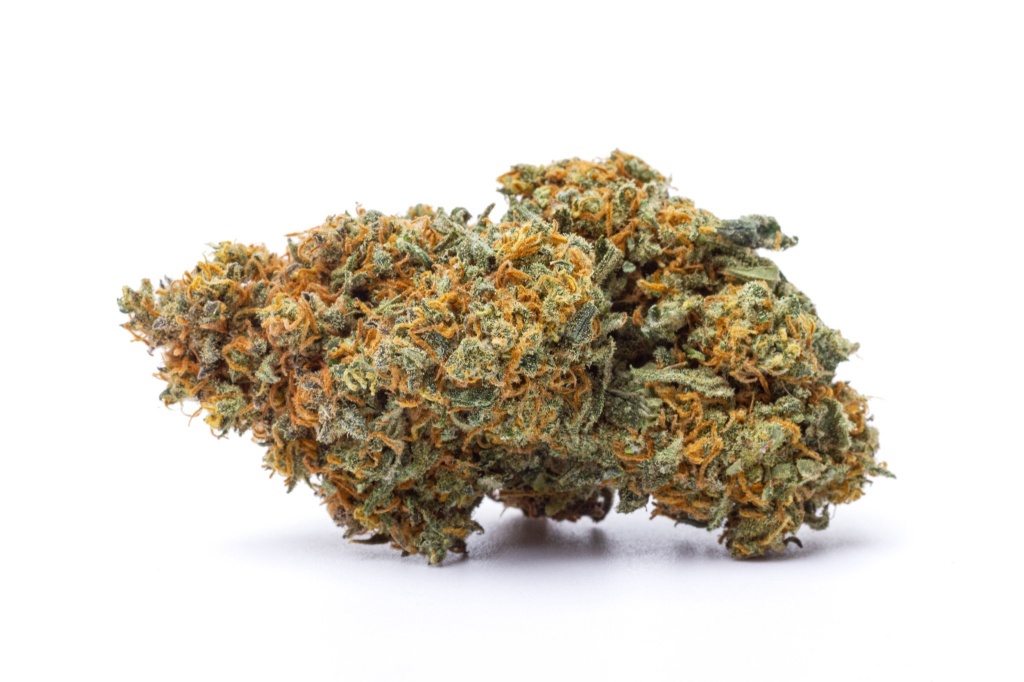
While weed has become less of a taboo in our society in the past few decades, many people still know nothing about the plant beyond what’s in the news—fearmongering and misinformation. GreenState is dedicated to countering those forces, educating people about cannabis, and engaging with all aspects of the plant. Whether you’re new to the weed world, an experienced user, or simply curious, this comprehensive cannabis 101 guide should prime you on the context behind the pieces on GreenState.
RELATED: This cannabis growth stage guide will take you on a plant journey
What is cannabis?
If you’re here, you probably know what cannabis is in a broad sense. You know, marijuana, weed, pot—whatever you want to call it. Still, you may not be an expert on what exactly the plant entails: that’s where we step in.
There are three variations of the cannabis plant. Sativa and indica are technically different species within the same family—the former originates from tropical climates, such as those found in Mexico and Thailand. At the same time, the latter was first discovered in Asian countries like Tibet and Afghanistan. This distinction is less important now, as the majority of strains now are hybridized. The terms sativa and indica are most commonly used to describe the distinct effects they provide to users.
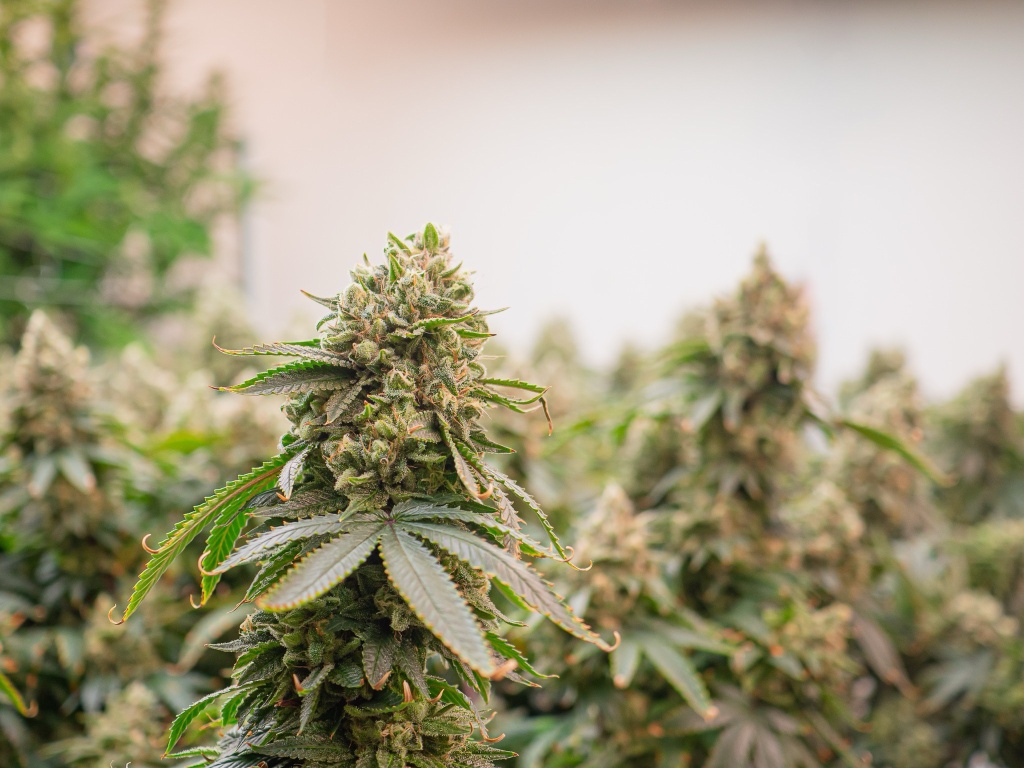
Sativa is typically known as giving energizing, uplifting highs, while indica helps with relaxation. However, there has been pushback within the cannabis industry regarding these definitions. Many argue that the terpene profile of a strain is more indicative of the effects (but more about that later).
Ruderalis is a lesser-known category. Its name comes from the word “ruderal,” meaning that it was the first to seed after land disruption, so the plant thrives in poor or harsh conditions. It’s believed to have originated in areas of Russia and Central Asia. Ruderalis varieties are also known as “autoflower” because they mature with age, as opposed to indica and sativa, which mature in response to light cycles.
RELATED: What does bad weed look like? How to tell if your bud is trash
Cannabinoids
Cannabis consists of compounds called cannabinoids. There are dozens and dozens in the plant, but you’ve probably heard of THC and CBD primarily. THC is the cannabinoid that gets you “high,” whereas CBD is the one that provides the therapeutic effects that are prevalent in many marijuana-based medicines.
Other cannabinoids you may have heard of include:
THCV – Found in certain strains, THCV is a slightly psychoactive cannabinoid believed to energize and boost focus. It also works for some as an appetite suppressant.
THCA – THCA is the chemical precursor to THC. A cannabis strain high in THC actually starts with high amounts of THCA. Once heated, whether by a lighter in a bowl or in an oven during baking, the THCA converts to THC. THCA is not known to be overtly psychoactive, but once that “A” drops off, the THC left behind will be.
CBG – CBG, or the “mother of all cannabinoids,” is the precursor of THC. It’s not particularly psychoactive, but it may help with focus, regulating stress, and managing inflammation. Others report it giving similar energy-boosting effects to caffeine.
CBN – CBN is the result of THC degradation due to oxidation or light/air exposure. Studies suggest that it could be used as a sleep aid and anti-inflammatory agent. It’s less psychoactive than THC, but can induce a small high if used.
CBV – CBV is related to THCV in the same way CBN is to THC. Its effects are not commonly studied, but given its relation to CBN, some imply that it can also be used as a sleep aid.
CBC – CBC is a relatively rare cannabinoid thought to have a range of potential benefits. It may also enhance the effects of more prevalent cannabinoids like THC.
Delta-8, Delta-9, and Delta-10 THC – Delta-9 THC is the compound found in traditional cannabis products that’s typically associated with the highs you’re familiar with. Delta-8 and Delta-10 occur in trace amounts in cannabis, so products that contain them are more than likely synthetic.
Delta-8 has psychoactive effects, but it isn’t quite as strong as Delta-9—if you’re looking for a less potent product, this cannabinoid may be for you. For many users, the compound solely provides relaxation.
There hasn’t been extensive research on Delta-10, but we do know that it’s significantly weaker than both Delta-8 and Delta-9. Similar to Delta-8, many users report stress relief.
RELATED: How to kickstart a career in cannabis
Terpenes
Cannabis plants also contain terpenes, which are compounds responsible for the distinct aroma and flavor. They’re also believed to drive the effects of individual strains. Terpenes (sometimes called terps) are found in all plants, with hundreds of different types in the natural world. However, there tends to be a select number prevalent in cannabis.
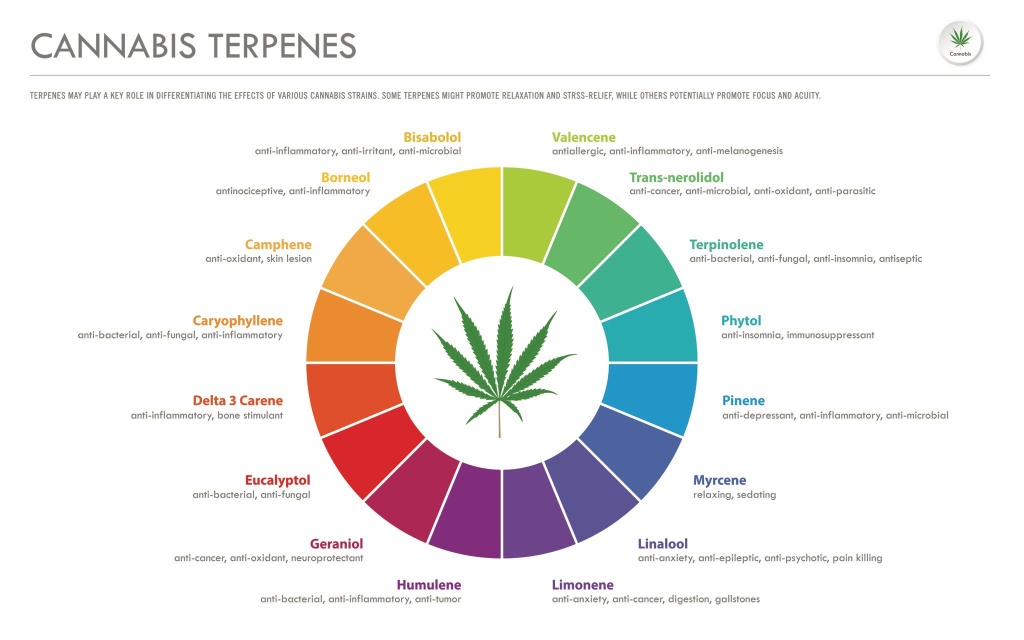
Common cannabis terpenes include:
Myrcene – Myrcene has anti-inflammatory, antimicrobial, and analgesic uses. It’s mostly found in indica strains and has sedative effects.
Limonene – This terpene is primarily known for its citrusy aroma and can be found in fruit rinds and cleaning products. It’s believed to provide anxiety and stress relief and has antifungal and antibacterial properties.
Pinene – Both alpha and beta-pinene are found in cannabis, sage, basil, and orange peel. They can provide an energy boost and suppress inflammation and anxiety symptoms.
Beta-caryophyllene – Beta-caryophyllene is present in herbs and spices like black pepper, basil, cinnamon, and oregano. It has a floral and earthy scent and offers several potential health benefits, including reducing alcohol intake and treating inflammation and inflammatory bowel disease. It’s the only terpene capable of directly activating a cannabinoid receptor.
Humulene – If you enjoy hops in beer, you’ve likely already encountered humulene. The woody and slightly spicy terpene has been used as an anti-inflammatory, antibacterial, and appetite suppressant for many. It’s a relatively common terpene in cannabis, although it typically occurs in lesser quantities.
Ocimene – Ocimene is a terpene attributed to many fan-favorite sweet cannabis strains—it’s also found in mint, parsley, and orchids, and is commonly used in perfumes. The substance protects crops from harmful pests, and one study suggests it may help alleviate symptoms of diabetes.
Terpinolene – Terpinolene is, of this list, the least prevalent in cannabis plants. While it’s found in many strains, it occurs in very small amounts. The terpene’s aroma mixes those of diesel, pine, flowers, citrus, and many other dimensions. It also has antibacterial, antifungal, and pest-repelling properties.
Linalool – Linalool has been documented as having anti-inflammatory, anticonvulsant, and sedative effects, as well as supporting neural function. It can also be found in mint, lavender, and some mushrooms.
RELATED: This is the biggest misconception about weed
Other prevalent cannabis compounds
Cannabis is an extremely complex plant. In addition to cannabinoids and terpenes, it contains other beneficial compounds like flavonoids, phenols, and amino acids. Scientists have only scratched the surface of the chemical makeup of cannabis. A recent study revealed ultra-rate flavoalkaloids in one particular variety of cannabis, highlighting the need for continued research into the plant.
Cannabis vs hemp vs marijuana
The words cannabis, hemp, and marijuana are often used interchangeably, but do they mean the same things?
Cannabis
Cannabis, as previously described, refers to Cannabis sativa L., the scientific name for the plant. All marijuana and hemp varieties are technically cannabis plants. Just like you have a beefsteak tomato or a cherry tomato, marijuana and hemp are variations. Their names are instead used to define their properties—and legal status.
Marijuana
Marijuana is defined by the government as a cannabis plant with more than 0.3 percent THC by dry weight. When people are talking about marijuana, they’re likely talking about an intoxicating cannabis variety. Some people use the terms cannabis and marijuana interchangeably.
RELATED: Cannabis and organ transplants: what you need to know
Hemp
Hemp is where it gets complicated. The 2018 Farm Bill made hemp, a form of cannabis, federally legal in the US. It’s defined as a cannabis plant that contains a concentration of no more than 0.3 percent THC by dry weight. This definition has become hazy in many ways, as things like drinks—which technically fit the bill based on dry weight but are still extremely intoxicating—and flower with THCA—another cannabinoid that becomes THC once burned—have been able to find markets in illegal states.
Efforts to regulate or ban hemp have picked up in certain states, and some have found success. The landscape really changes every day.
Cannabis law
Cannabis law is simple on the surface, but when you really get into the weeds (pun intended), it gets complex. The plant is illegal federally. It is currently classified as a Schedule 1 drug, meaning it has a “high potential for abuse and is not currently accepted for medical treatment federally.” Multiple initiatives have been enacted to get the drug rescheduled or descheduled—so far, they’ve gone nowhere.
Despite its Schedule I status, the majority of states have enacted some type of policy reform. This may include full legalization of cannabis for adults (known as recreational and/or adult-use) or legalization of medical cannabis/marijuana. Here’s a quick breakdown of the difference.

Adult-use cannabis
So far, 24 states have legalized recreational adult-use cannabis. This means any adult 21 or over can legally purchase and possess cannabis products. The amount of cannabis someone can buy or have varies from state to state. The brands or product types may also vary from state to state. Technically, you can not bring adult-use cannabis products from one state to another, even if they’ve both legalized.
Medical cannabis
At this time, 40 states have approved some type of medical cannabis. Every state’s rules vary, but in most cases, an individual must apply for a special card showing they’re allowed to purchase cannabis products. This application includes a recommendation from a medical professional certifying the person has one of the state’s approved “qualifying conditions.” Common qualifying conditions include chronic pain, epilepsy, AIDS, cancer, and anxiety.
Some states make it very easy to obtain medical cannabis; others are more restrictive. Certain states, like Maine and Hawaii, will allow out-of-state residents with medical marijuana cards to purchase products. Others will only allow current residents to buy.
RELATED: Overlooked part of cannabis plant shows medical potential
The history of cannabis prohibition
Perhaps surprisingly, cannabis has been prohibited in the US for less than 90 years. Before the Marijuana Tax Act of 1937, the plant was included in the US Pharmacopeia and was used for a plethora of conditions that caused inflammation and other ailments.
Harry Anslinger, the former commissioner of the Federal Bureau of Narcotics, drafted the Act, intentionally using the Mexican word ‘marihuana,’ instead of ‘cannabis.’ In it, he proposed levying taxes on hemp and cannabis products, including for physicians and pharmacists.

His move had varying levels of support. Some, like William Randolph Hearst, supported the legislation because hemp was a competitor to the timber industry. Others, like Dr. William C. Woodward, claimed that Anslinger’s bill “loses sight of the fact that future investigation may show that there are substantial medicinal uses for cannabis.”
This rejection of the plant as having any medicinal value fully materialized in the 1970s, when the Controlled Substances Act listed cannabis as a Schedule 1 drug, meaning it has a “high potential for abuse” as well as “no accredited medical use.”
Criminal justice reform
Some states have done the work to ensure that recent legalizations retroactively provide clemency to those previously convicted of marijuana possession or use. Still, many people remain incarcerated because of the plant. The federal government does not publish exact numbers, but groups like the Last Prisoner Project are committed to telling their stories.
According to a BJS report released in 2021 using data from 2018, it is estimated that there are around 32,000 cannabis prisoners in the US, 10,000 being at the federal level. Of the 300,000 people arrested for cannabis possession in 2021, 38.8 percent were Black (despite only making up 13.6 percent of the country’s population and using weed at similar rates as white people).
RELATED: Get high and give back with these weed brands
Ways to consume cannabis
Contrary to popular belief, the words blunt, joint, and spliff are not synonyms. All of them are vessels for smoking weed, but each has its own distinct properties that could make one method the best for you. For a rundown of all the creative ways stoners have found to smoke, check out this article.
Aside from traditional smoking methods, there are many other ways to imbibe cannabis. Every way of consuming weed has its benefits, and at the end of the day, it’s a personal preference. Here are some of the most common methods.
Smoking flower
Smoking flower is the classic option for consuming weed. Cannabinoids like THC or CBD enter the bloodstream through the lungs. You may enjoy it if you prefer a rich, thick smoke that packs a lot of flavor—also, if you want the effects to kick in fairly quickly. While efficient, your lungs are at risk whenever you inhale any kind of smoke, especially if mixed with any form of tobacco.
Vaping
Vaping is another way to inhale cannabis. People can either vape flower using a dry herb vaporizer or a vape pen, which contains cannabis oil. Consumers who seek a discreet way to consume tend to gravitate toward vaping. Dry herb vaporization is thought to be less risky than smoking (aka combustion). Vape pens often receive a bad reputation due to the risks associated with the hardware used and the potential presence of additives in the oil.
Dabbing
Dabs are cannabis concentrates high in THC. They come in a variety of forms, including badder, wax, and rosin. Dabs are consumed using a special rig that heats the extract to a high temperature. Dabbing is preferred by people with a high tolerance to THC and/or medical patients who need larger doses of cannabinoids.
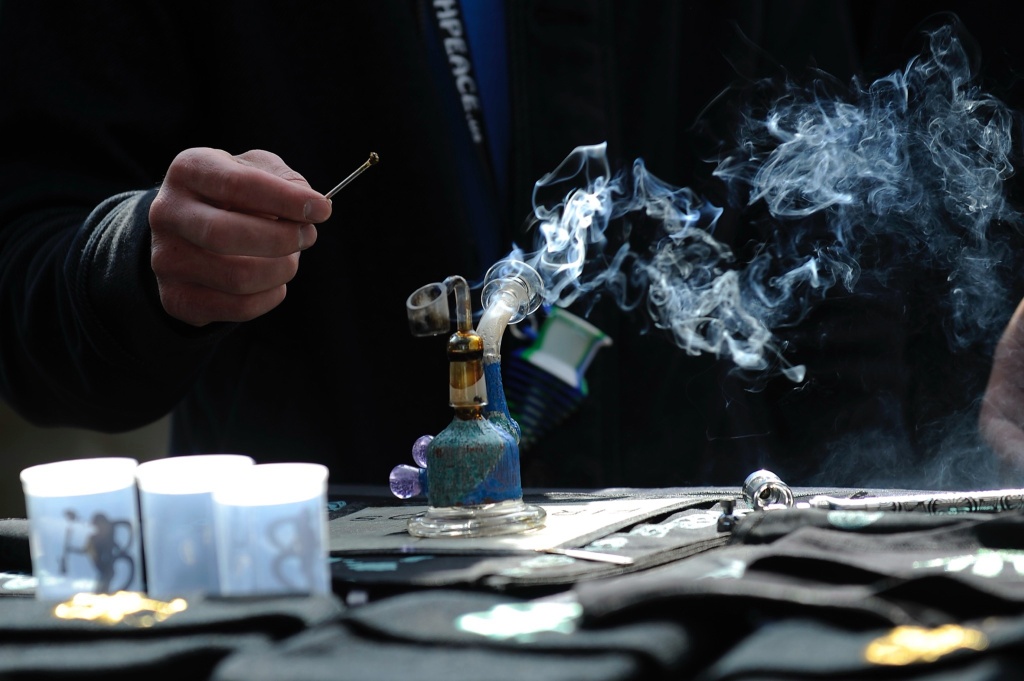
Edibles
Cannabis-infused foods, such as gummies, drinks, and chocolates, are processed through the liver. They tend to take a longer time to kick in compared to inhalation methods, and may result in more pronounced effects. People who do not wish to smoke or vape enjoy cannabis edibles, but it’s important for newcomers to always start with a very small dose since they can “hit harder.”
RSO/Tinctures
Cannabis oil can also be consumed orally via tinctures or Rick Simpson Oil (RSO). Both are cannabis extracts made using an alcohol-based extraction method. RSO tends to be extremely potent and is used by medical patients. Tinctures are less viscous and may also contain a carrier like MCT oil. Tinctures can be put in drinks or placed under the tongue for quicker absorption.
Topicals
Topicals aren’t meant to get you high, so if that’s what you’re looking for, go elsewhere. Cannabis lotions and balms are typically intended for medical purposes, offering targeted relief from aches and pains, bug bites, and other conditions. They’re easy to apply and can be used without worry of intoxication.
Suppositories
Suppositories are a form of topical that are inserted anally or vaginally. They’re used for many reasons, ranging from alleviating menstrual cramps to cancer symptoms. Again, they aren’t meant to get you high, but they’re known to provide fast-acting relief.
RELATED: 5 rolling trays perfect for any type of sesh
Are certain ways of consuming weed safer than others?
All ways of using weed are not made equally. While consuming cannabis in any form comes with a risk depending on who you are, there are a multitude of factors that should be taken into account when deciding how you want to use it.
Inhaling smoke of any kind is always a risk, as it can have respiratory effects, chemicals can change with heat, and effects can accumulate with prolonged use. If you really prefer smoking, opt for a joint over a blunt, as the latter are wrapped in tobacco and usually contain much more flower.
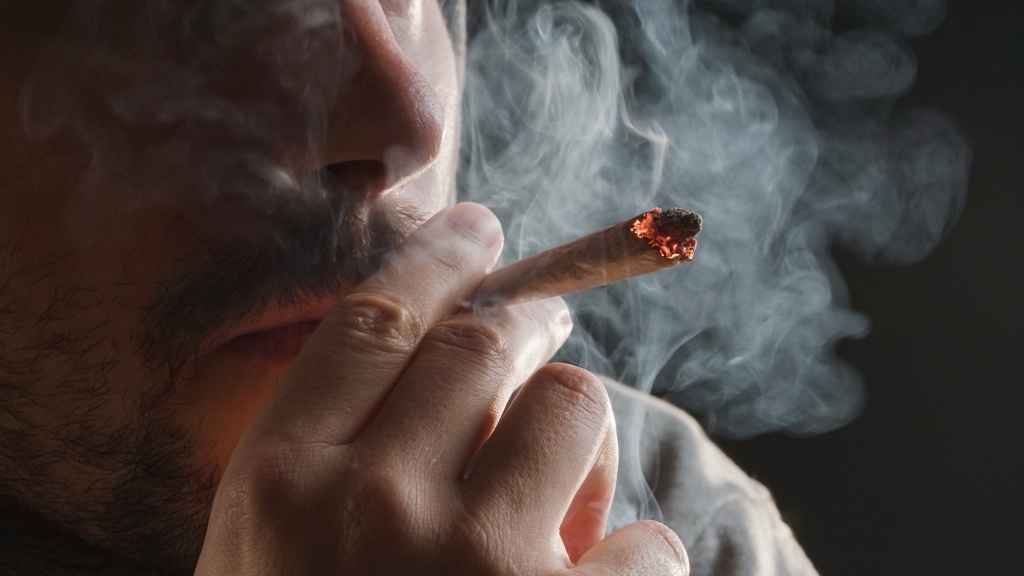
Bongs and dabs usually feel smoother and less harsh, but don’t let that fool you. Our lungs can’t distinguish between the two.
Many users assume that vaping is a safer alternative to smoking, but the devices carry their own risks. There’s evidence that THC vape cartridges expose users to heavy metals and have never been properly tested for adverse effects.
Edibles and tinctures are thought to be a less risky way to consume cannabis. However, their effects can be a lot stronger and last longer than smoking or vaping.
“Greening out”
It can be easy to overdo it on cannabis, especially if you’re new to the plant. A common term for overconsumption is “greening out.” Symptoms may include fatigue, anxiety, rapid heartbeat, sweating, or nausea.
If you find yourself in a green out, there are steps you can take to alleviate the unease. Many people find that going for a walk, eating a snack, or washing their face helps. You may distract yourself with a comfort TV show or by calling or texting a friend. The good news is it will pass.
RELATED: Got too high? This product can help
Medical use of cannabis
Despite the cannabis plant’s Schedule 1 status, it has and continues to be used therapeutically. From reducing anxiety to quelling cancer symptoms, cannabis has improved the quality of life of millions around the globe.
As of right now, the FDA has approved four cannabis medications: Epidiolex, Marinol, Syndros, and Casamet.
Epidiolex is a CBD treatment primarily used to treat seizures associated with tuberous sclerosis complex that is safe for patients one year and older. Marinol is a medicine that contains a synthetic THC-like chemical that helps with weight loss related to chemotherapy treatments and AIDS. Casamet treats nausea and vomiting associated with cancer.
Besides the officially approved medications, many people self-medicate using weed. Studies show that the plant can positively affect people with dementia, neuropathy, depression, and more. Different strains, because of their unique combinations of cannabinoids and terpenes, are able to bind to receptors in the body in ways that relieve pain and other symptoms of a plethora of conditions.
RELATED: Cannabis compound may reverse serious effects of aging
Other uses for the cannabis plant
Cannabis isn’t just good for feeling good. The plant has historically had many alternative uses that benefit even those who are least inclined to use it in their personal life.
In the 16th and 17th centuries, the hemp crop was utilized as a source of fiber for ropes and textiles—its durability and ease of production made it an attractive option for potential growers. As the Revolutionary War began and settlers divested from British imports, they used hemp even more to create clothes, ship sails, and riggings. In the 19th century, over 5,000 tons of hemp were grown in Virginia annually.
Hemp textiles have experienced a resurgence in recent years. Popular brands like Patagonia and Jungmaven utilize the plants in their clothing, ensuring they support American hemp farmers in the process. Hemp building materials (like hempcrete) are also gaining traction as people seek alternatives to wood buildings.

Cannabis has also been used in food production. For one, researchers at Chiang Mai University found that feeding cannabis to chickens made for better quality meat. Chickens that ate the 0.5 percent cannabis feed created a higher volume of meat, while the one to two percent groups produced more breast and intestinal meat. The meat also exhibited improved fluid retention compared to before.
Hemp oil may also help create quality gluten-free baked goods. If you’ve ever had a flourless pastry, you know they can get crumbly and dry, but hemp may be the solution. A team of researchers from the University of Calabria found that when the products were made with hemp flour, they were a bit more chewy. It’s not a fully fleshed-out method yet, but if you don’t like almond or corn flour, hemp may be a good option.
RELATED: Spaceships may one day be made from hemp
Cannabis 101 is just the start
Hopefully, this canna recap was enough to provide you with a base level knowledge of cannabis, but if you want to know more, GreenState’s got you covered. For articles about cannabis products, famous stoners, and the shifting laws on the plant, check out our entire archive.